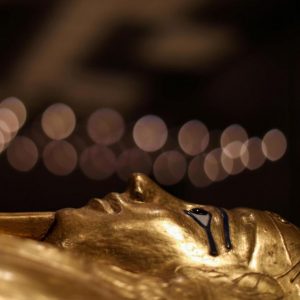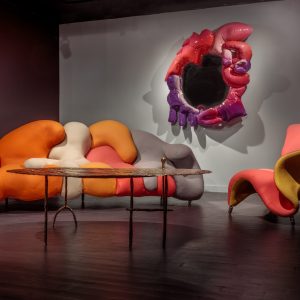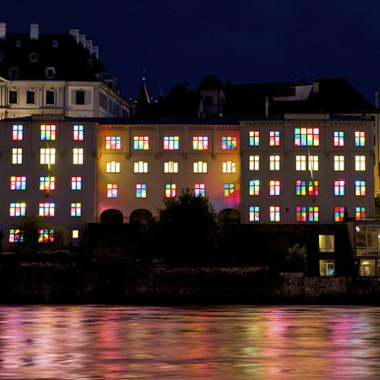Link About It: This Week’s Picks
Cairo’s mummy parade, VR-created claymation furniture, the importance of “third places” and more in our look around the web

Watch the New York Academy of Art’s Tribeca Ball Program
 To accompany the annual sale of work by hundreds of emerging artists at their beloved spring benefit known as the Tribeca Ball, the New York Academy of Art compiled a star-studded program that includes a tribute to fine artist Eric Fischl, as well as thoughtful advice to art students. Traditionally held among the academy’s halls (and within their art studios), the extravaganza took place online this year and is available for all to see. In addition to watching the 45-minute video, those interested can browse and buy the art—an act that sustains the institution, which was founded by artists (including Andy Warhol) in 1982. New art will be added online every Monday through 19 April and the work is on view through 2 May. Check it out at TribecaBall.com now.
To accompany the annual sale of work by hundreds of emerging artists at their beloved spring benefit known as the Tribeca Ball, the New York Academy of Art compiled a star-studded program that includes a tribute to fine artist Eric Fischl, as well as thoughtful advice to art students. Traditionally held among the academy’s halls (and within their art studios), the extravaganza took place online this year and is available for all to see. In addition to watching the 45-minute video, those interested can browse and buy the art—an act that sustains the institution, which was founded by artists (including Andy Warhol) in 1982. New art will be added online every Monday through 19 April and the work is on view through 2 May. Check it out at TribecaBall.com now.
Image courtesy of Ellie Kayu Ng, NYAA MFA 2021
Cairo Hosts Real Mummy Parade For National Museum of Egyptian Civilization Opening
 To commemorate the opening of Cairo’s National Museum of Egyptian Civilization, 22 ancient Egyptian royal mummies were carefully paraded across the city in elaborately decorated, oxygen-free nitrogen capsules alongside costumed performers. The final destination was their new resting place within the walls of the long-awaited museum. Artnet explains, “Safely moving the millennia-old remains was a multimillion-dollar affair that involved building special shock-absorbent vehicles as well as repaving the roads along the route to ensure a smooth ride.” The 18 kings and four queens will be on view in the museum’s royal hall starting 18 April, though the museum itself opened its doors on 4 April. See photos of the parade and learn more about the museum at Artnet.
To commemorate the opening of Cairo’s National Museum of Egyptian Civilization, 22 ancient Egyptian royal mummies were carefully paraded across the city in elaborately decorated, oxygen-free nitrogen capsules alongside costumed performers. The final destination was their new resting place within the walls of the long-awaited museum. Artnet explains, “Safely moving the millennia-old remains was a multimillion-dollar affair that involved building special shock-absorbent vehicles as well as repaving the roads along the route to ensure a smooth ride.” The 18 kings and four queens will be on view in the museum’s royal hall starting 18 April, though the museum itself opened its doors on 4 April. See photos of the parade and learn more about the museum at Artnet.
Image courtesy of the National Museum of Egyptian Civilization
Artist Misha Kahn’s “Watermelon Party” Exhibit for Dries Van Noten
 Two retail structures—referred to as The Big House and The Little House—form Dries Van Noten’s 8,500-square-foot, open-layout Los Angeles store, which opened in October of last year. The Big House showcases current collections by the Belgian fashion designer, while The Little House plays host to exhibitions by collaborative artists. Now through 6 May, sculptor Misha Kahn occupies the latter with Watermelon Party, an exhibition of fanciful VR-created claymation furniture. As expected, they’re whimsical, weird and wonderful. Dries Van Noten and Kahn also collaborated on a limited edition silk bomber jacket and T-shirt, designed by Van Noten and featuring a motif by Kahn. Read more about the space and collaboration at Grazia.
Two retail structures—referred to as The Big House and The Little House—form Dries Van Noten’s 8,500-square-foot, open-layout Los Angeles store, which opened in October of last year. The Big House showcases current collections by the Belgian fashion designer, while The Little House plays host to exhibitions by collaborative artists. Now through 6 May, sculptor Misha Kahn occupies the latter with Watermelon Party, an exhibition of fanciful VR-created claymation furniture. As expected, they’re whimsical, weird and wonderful. Dries Van Noten and Kahn also collaborated on a limited edition silk bomber jacket and T-shirt, designed by Van Noten and featuring a motif by Kahn. Read more about the space and collaboration at Grazia.
Image courtesy of Dries Van Noten
ABIBOO’s Cliff-Face Concept City for Mars
 Designed for the non-profit Mars Society, architecture studio ABIBOO’s Nüwa concept city represents a permanent, self-sufficient settlement built into a cliff face on the Red Planet. ABIBOO believes the vertical habitat could be built in 2054, using Martian materials, and house 250,000 people. The studio worked with the with scientific group SONet to address several technical details. Nüwa, which ABIBOO refers to as the “future capital of Mars,” would incorporate interconnected underground tunnels that jut out from the cliff to allow for natural light, hydroponic systems for food production and solar power systems for electricity. See more imaginative renderings at Dezeen, where ABIBOO founder Alfredo Munoz outlines the firm’s vision.
Designed for the non-profit Mars Society, architecture studio ABIBOO’s Nüwa concept city represents a permanent, self-sufficient settlement built into a cliff face on the Red Planet. ABIBOO believes the vertical habitat could be built in 2054, using Martian materials, and house 250,000 people. The studio worked with the with scientific group SONet to address several technical details. Nüwa, which ABIBOO refers to as the “future capital of Mars,” would incorporate interconnected underground tunnels that jut out from the cliff to allow for natural light, hydroponic systems for food production and solar power systems for electricity. See more imaginative renderings at Dezeen, where ABIBOO founder Alfredo Munoz outlines the firm’s vision.
Image courtesy of ABIBOO
The Pandemic Stripped “Third Places” From Our Social Infrastructure
 For most, a favorite bar, coffee shop, library, record store, barber shop or market means more than a transaction. These “third places” (home being first and work second) oftentimes provide conversation, connection and community. However, many—if not most—of these places were forced to close or operate at reduced capacity last year and, until PPP Loans arrived, with limited financial support from the government. Some cities offered aid through tax rebates. Others sought ways to direct foot traffic from malls and bigger chains to downtown corridors where small, independent businesses struggled to stay afloat. But the absence of these “third places” also impacted individuals’ wellbeing. “We form very physical attachments, both to people but also to places, and without that I think our lives will not be as rich. What’s lost is the sensory sense of being with other people. I don’t think we know yet what the consequences of that will be,” Setha Low, environmental psychology professor at the Graduate Center of the City University of New York, tells CityLab. Read more there.
For most, a favorite bar, coffee shop, library, record store, barber shop or market means more than a transaction. These “third places” (home being first and work second) oftentimes provide conversation, connection and community. However, many—if not most—of these places were forced to close or operate at reduced capacity last year and, until PPP Loans arrived, with limited financial support from the government. Some cities offered aid through tax rebates. Others sought ways to direct foot traffic from malls and bigger chains to downtown corridors where small, independent businesses struggled to stay afloat. But the absence of these “third places” also impacted individuals’ wellbeing. “We form very physical attachments, both to people but also to places, and without that I think our lives will not be as rich. What’s lost is the sensory sense of being with other people. I don’t think we know yet what the consequences of that will be,” Setha Low, environmental psychology professor at the Graduate Center of the City University of New York, tells CityLab. Read more there.
Image courtesy of Edward Howell on Unsplash
Link About It is our filtered look at the web, shared daily in Link and on social media, and rounded up every Saturday morning. Hero image courtesy of ABIBOO












